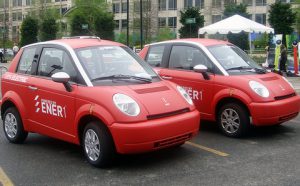In the bike-loving Netherlands, electric bicycles now account for one-third of bicycle spending. The e-bike is encroaching on the Vespa in Rome, and multiplying on the steep roads of Lausanne. Globally, the production of electric bicycles is expected to increase by roughly a million units each year through 2020.
As European and US cities brace for an invasion of the battery-powered bikes, they have a clear test case in China, where more than nine in ten e-bikes are sold worldwide.
That’s not to say that Chinese cities have figured out how to grapple with the legal, cultural and environmental implications of electric bicycles. Should they be treated like regular bikes or motorcycles? Can they solve the transit problems of a 21st century city, or should they be banned altogether? The conflicting decisions of national and municipal authorities in China has demonstrated the difficulty of adapting to a new mode of transportation.
Car ownership in China was uncommon until recently: in 1998, the Chinese owned four million cars. By 2008, that number had grown to 35 million. Between 1995 and 2005 bicycle ownership fell from 1.9 to 1.1 bicycles per household. There has arguably been a corresponding shift in social attitudes, with car ownership becoming a status symbol: a couple of years ago a model on a Chinese dating show proclaimed she would "rather cry in a BMW than laugh on the backseat of a bicycle."
The effect has been particularly pronounced in cities. Cycling has declined in nearly all of China’s major cities in the 21st century – in Beijing, for example, cycling as a percentage of trips fell from 60% in 1986 to under 20% in 2009. Such statistics remain decades in the future for most US cities. In Portland, Oregon, something of a paradigm for an American cycling city, bicycle use accounts for around 6%.
The difference can partially be explained by China’s electric bicycle culture. It’s estimated that there are well over 120 million such bicycles in China, up from tens of thousands in the late 1990s. It seems unlikely that any other transportation technology in history has experienced a decade of such growth. One in five Chinese bicycles has a battery, and that ratio is likely to be higher in urban areas.
The transition has not been smooth. At first, China endorsed the bikes as a cleaner alternative to electric scooters and mopeds. But when the trend really took off in the early years of the new millennium – some attribute the boom to urbanites being wary of public transport after the SARS outbreak, others have pointed to municipal bans on gas-powered scooters – many cities moved in the opposite direction. Some banned the electric bicycle after national crash deaths skyrocketed from the single digits into the thousands. In Shenzhen, electric bicycles were involved in 15% of all traffic accidents in 2011, and the city subsequently banned the e-bike.
In many places, policy has wavered. Beijing banned the e-bikes in 2002, only to change course and allow them in 2006. The Chinese government threatened new regulations in 2009 that would have made the e-bike the legal equivalent of a motorcycle, only to back down in 2010. In Guangzhou, where bikes were banned in 2007 but remain in wide use, a government crackdown this summer brought accusations that the law was enforced at the whim of the fine-happy police.
As cities worldwide watch their electric bicycle numbers increase, they have faced similar dilemmas. In Singapore, there is growing concern about the rising number of electric bicycles and their effect on road safety. In New York, though e-bike use remains uncommon, the City Council has twice banned them.
There are also environmental concerns about e-bikes: in China lead-acid battery production has been increasing by double-digit percentages, in part to meet demand for e-bikes – China is manufacturing about 30 million e-bikes each year, up from 1.5 million a decade ago. And no one has yet determined whether electric bicycles are really drawing commuters out of their cars, or if the new riders would otherwise be riding conventional bicycles.
In Copenhagen, which will debut a bikeshare program next spring involving 1,200 electric bicycles with GPS navigation screens, the critique is simpler: why bother? The e-bike is perceived by many there as being a prohibitively expensive version of a vehicle that already works well: Copenhagen’s e-bicycles will cost an astounding US$ 8,000 each.
Alternative transportation advocates, though, continue to see the electric bicycle as a potentially revolutionary device.
In Beijing, for example, if electric bicycles could recover some of the usage lost by bicycyles to cars, the effect on the city’s notorious air quality problems (not to mention traffic and parking issues) would be enormous. Proponents believe the e-bike also has the potential to draw in commuters who would never have considered a trip on a standard bike or can’t afford to purchase an electric car.
“E-bikes disrupt car use,” says Christopher Cherry, a professor of civil and environmental engineering at the University of Tennessee at Knoxville. One in five Chinese e-bike riders, according to Cherry, are would-be car drivers.
But if e-bikes are really a potential rival for cars, China’s approach could not be more counter-productive. In response to the rising incidence of electric bicycle accidents, China has clamped down on the medium rather than encouraged it.







